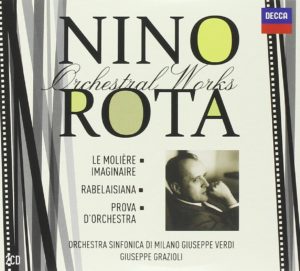Nino Rota was a craftsman composer, and he drew his musical raw materials from far and wide. Indeed, elements of baroque music, medieval music, world music, sentimental ballads, the music of Italian village bands, and, after his trips to America in the 1930s, the music of Gershwin fill the scores of this musical kleptomaniac. But, in the final work of this third installment of Decca’s ongoing Rota series, it is in 20th-century Russia that we find ourselves. The Piano Concerto in E minor is a slice of late-Romantic nostalgia that might have been written by Rachmaninov himself.
The work is also available in a 1973 recording with Riccardo Muti and the Orchestra Filarmonica della Scala. That recording has a steelier quality than we get here, with Muti, an ex-student of Rota, coiling the tension and finding special grit in the finale. But in this rendition conductor Giuseppe Grazioli’s preference for pastel colors and fluid tempos feels better suited to this essentially wistful music, and La Verdi, which in recent years has taken to the Romantic idiom as if born to it, is irrepressible as it surges in and out of the spotlight. Pianist Simone Pedroni plays with a soft touch and plenty of pedal, and shows metal in the first-movement cadenza.
Elsewhere, music inspired by France predominates. Rabelaisiana–a three-movement song setting of poems from 16th-century poet Francois Rabelais’ Gargantua–evokes the intoxicating quasi-symbolistic language of, say, Scriabin. And, in this world-premiere recording, the songs are impressively dispatched by the stratospheric soprano Valentina Corradetti. She raises a smile when blithely reeling off a list of those forbidden to pass through the gates of the fantastical Thélème in the first-movement “Inscription”; strikes a visionary tone when fervently quavering over voluptuous orchestra in “L’oracle de la bouteille”, a rapt hymn to the divine properties of liquor; and seduces when imploring us to lose ourselves to pure consciousness in the heavily-perfumed, Bacchic “Io Paen”.
Lighter in tone, Le Molière imaginaire is a ballet for the choreographer Maurice Béjart sunnily depicting life at Louis XIV’s court. Rota’s 29 miniature movements comprise Lully-esque dances and royal marches; but there are also mandolins from the Italian South, and an aural panoramic entitled “La baptême avec le Roi” that, as with the prelude to Puccini’s Tosca, conjures a cityscape in crisp, wintry tints and church (tubular) bells backgrounding, in this case, an unmistakably Rotarian melody. All in all this is not the composer’s pithiest work, but it makes for pleasingly easy listening.
































